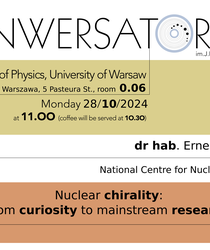
Open lecture
dr hab. Ernest Grodner
Narodowe Centrum Badań Jądrowych, Warszawa
Oct. 28, 2024, 11 a.m.
ul. Pasteura 5, 0.06
Abstract:
Two decades ago the existence of the nuclear chirality phenomenon was experimentally confirmed for the first time thanks to the cooperation of two Warsaw University units, i.e. the Faculty of Physics and the Heavy Ion Laboratory. Among various types of chirality in science, the nuclear one deals with low energy collective nuclear excitations. Initially, the nuclear chirality research covered only a few strictly characteristic isotopes and was considered an interesting curiosity with a significant degree of risk. The next two decades were characterized by a rapid development of nuclear chirality study, both theoretical and experimental. Numerous chiral-characteristic signatures and phenomena have been predicted and observed. Not only has the range of isotopes (over 60 today) recognized as chiral expanded from odd-odd through odd-even up to even-even nuclei but also the number of chiral structures in excitation level schemes in single nuclei has been multiplied. Today, in some isotopes a set of chiral excited states is comparable to the set of other excited states in the same energy range. The chirality effect from a niche topic grew up to the mainstream of nuclear spectroscopy. National Centre for Nuclear Research in cooperation with Heavy Ion Laboratory remains at the forefront of chirality research actively setting the direction of further study.
